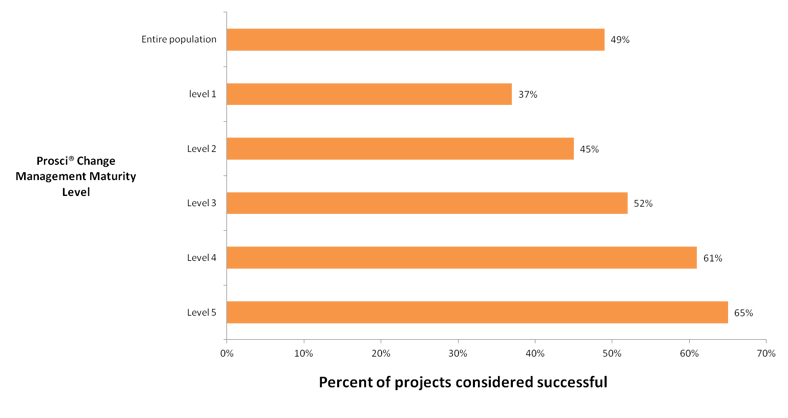 In our recent blog post "Transformation in Financial Technology & Change Management Adaptation", we briefly mentioned that the Asia-Pacific (APAC) region change management maturity model level ranking was ahead in terms of the global average.
In our recent blog post "Transformation in Financial Technology & Change Management Adaptation", we briefly mentioned that the Asia-Pacific (APAC) region change management maturity model level ranking was ahead in terms of the global average.
However, is surpassing the average enough?
Understanding Prosci® Change Management Maturity Model™
The levels of the Prosci® Change Management Maturity Model™ describes the overall deployment and maturity of change management (CM) within a company.
- Level 5: Organisational Competency - CM is part of the skillset of the company.
- Level 4: Organisational Standards - A common CM approach with clear standards has been implemented in the company.
- Level 3: Multiple Projects - Structured CM approach is localised to a few particular teams or functions.
- Level 2: Isolated Projects - Elements of CM are used sporadically in a few projects.
- Level 1: Absent or Ad hoc - Project teams are not aware of change and do not use any formal CM methods.
Interested to find out about your organisation's maturity level? Download your free guide to Prosci® Change Management Maturity Model Audit here.
How does APAC fare?
Figure 1: APAC's organisations segmented by CM Maturity Model Level

Data source: 2016 Prosci® Best Practices in Change Management Benchmarking Report
According to the 2016 Prosci® Best Practices in Change Management Benchmarking Report, just 13% of the organisations in APAC have achieved Level 4 and 5 maturity. This means most organisations in APAC have not implemented a structured method to manage the people side of change.
Now let's understand how this stacks up against business outcomes.
Figure 2: Project Success rates by maturity

Data source: 2016 Prosci® Best Practices in Change Management Benchmarking Report
As an organisational begins the process of internalising change management as part of their organisational DNA, it can typically take 2-3 years to progress to the next level, accounting for variations in size or complexity.
By examining success through the proxy of average project success rates, we can see that across the world, organisations at Level 5 are able to achieve their desired business and non-business outcomes 65% of the time. Whereas, Level 1 organisations typically only yield percentage of 37% or less.
With a large percentage (77%) of APAC’s organisations currently at Level 2 or Level 3 and a further 10% at Level 1 these figures are perhaps concerning for APAC’s companies.
This indicates that approximately only 37% to 52% of APAC’s projects are likely to be achieving their desired objectives and return on investment
Weak change capabilities in companies often result in projects failing to meet business objectives, timescales, and budget. As a result of employee unawareness of or resistance to change; the adoption rates of new systems are low, while speed of adoption is sluggish and proficiency is diminished.
Implementing Change Management consistently and systematically is vital to achieving desired outcomes.
According to Boston Consulting Group, the change management industry has been growing significantly over the years and companies have been increasing spending on change management advisory services.
However, in spite of all the hype and expenditures, investment in change management capabilities has not necessarily translated into desired business outcomes. Based on self-reported CEO data, findings indicated that "50% of change programs fail to achieve their objectives; the failure rate rises to 75% for more complex and ambitious programs."
 The stakes of failing are high. Senior executives, most notably CEOs and other Senior Executive leadership, risk losing their jobs as billions of potential value is lost.
The stakes of failing are high. Senior executives, most notably CEOs and other Senior Executive leadership, risk losing their jobs as billions of potential value is lost.Well, aside from the reasons mentioned in our previous post, the next most apparent reason is that the change teams in many organisations 'cherry pick' components of change management methods and apply them inconsistently.
Measuring projects spanning across 18 years and across the globe, Prosci's research discovered that projects with best practices of change management are 96% more likely to meet or exceed their objectives. That is six times more than projects without change management or with poor execution of it.
Are you worried about your organisation's change capabilities? Get in touch with us to find out how to implement change management in a structured and systematic approach to ensure your change project deliver successful outcomes




